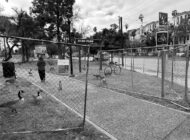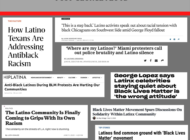By JUANA MORA
Several weeks ago I had a conversation with someone about the impact of the current economic crisis on the health of Latinos in the U.S. This person’s perspective was that, Latinos in the U.S. have never had equal access to health care and therefore the economic crisis is “nothing new”, particularly among those who are in lower economic brackets. This is probably true. A majority of lower income Latinos who live and work in the U.S. do not have access to health care. In the U.S., 15.3 million Latinos lack health insurance because although they are most likely to be working, the jobs where they work do not offer health insurance. When Latino families are not covered by health insurance, they take care of their family’s health care needs by, waiting until the person is very ill and then take them to the emergency room, driving across the border for medical care and medications, sharing medications with neighbors and family or simply rely on home health remedies. While these serve health needs on an emergency basis, they are not substitutes for having a regular health care provider who can track a person’s health over time.
Some of the most pressing health care needs for Latinos are prenatal health care, early childhood health, dental health, mental health, environmental health, reproductive health, diabetes, HIV- AIDS, hypertension and heart disease and alcohol related cirrhosis of the liver. Many of these health problems can be addressed with access to health insurance and the recent legislation to authorize the State Children’s Health Insurance Program by President Obama is a good start in the right direction. It is projected that this health insurance program will cover an additional 1.5 million uninsured Latino children. National health care reform may also have some positive results for the improvement of health in Latino families and communities.
One of the issues that has been talked about in medical and health circles is the idea that the longer Latino immigrants live in this country, the greater risk there is to their health due to increases in alcohol and other drug use, smoking, poor diets and less physical activity. According to leading health experts, immigrants come to this country at some risk to their physical well being and mental health. So what happens to an apparently healthy immigrant lifestyle after several years of residing and working in the U.S.? Part of the changes that occur as immigrants adapt to the U.S. is that their daily habits and environments change. For example, it is more likely that when immigrants, particularly immigrant children or the children of immigrants grow up in the U.S. they will be exposed to and eat more fast food, will not have access to home grown foods that they may have had in their home countries and may be more likely to be raised in unsafe and unhealthy, low-income neighborhoods. There is also less physical activity, particularly for immigrant children who remain indoors sometimes for many hours at a time watching TV while their parents work. These are not optimum conditions for healthy growth and prosperity.
The health status of Latinos is also affected by the environmental conditions of the places where they live, work, play and raise their children. When immigrants arrive in this country, they are usually not able to rent homes in clean, safe neighborhoods or afford expensive, nutritious food. The majority of Latino immigrants live in crowded, urban environments associated with all the risks to health and safety such as over concentrations of liquor stores, air pollution from industrial facilities and freeways. In many parts of the U.S., Latinos and other communities of color shoulder a disproportionate health burden because the areas where they live are often used as areas where toxic waste is dumped. There is also greater exposure to pesticide runoff lead exposure due to old housing, trash, graffiti and air pollution. It has been estimated that environmental exposures contribute to 10 to 20 percent to the cause of diseases including respiratory illnesses, developmental delays and learning disabilities, cancers and birth defects. A 2004 report of the impact of power plant pollution and the effects on Latino health issued by the League of Latin American Citizens found that 71 percent of Latinos in the U.S. live in counties that violate federal air pollution standards. These environmental conditions are clearly hazardous to the health of Latino immigrant families and children.
Acculturation into U.S. health norms and environmental risks contribute to the poor health outcomes of Latinos but the differences in health between Latinos and whites can also be explained by a noted difference in the quality of health care received. According to a 2003 report by the Institute of Medicine, racial and ethnic minorities tend to receive lower-quality health care than whites do, even when insurance status, income, age, and severity of conditions are comparable. According to this study minorities and persons of lower socioeconomic status are less likely to receive cancer screening services and more likely to have late stage cancer when the disease is diagnosed; they are less likely to receive recommended diabetic services and are more likely to be hospitalized for diabetes and its complications. Thus, in addition to changes in daily habits, poor quality of health care even for Latinos who are insured, also adds to the increasing negative health outcomes for Latinos. What can immigrant families do to prepare for the opportunities as well as the risks of immigration?
While the outlook for Latino health looks grim there are strengths within our culture that can be protective of health. We can maintain some of our traditions, including growing our own food even if there is a small space to do so, we can listen to our abuelos y abuelas to learn about how they lived and stayed healthy and we can advocate for safer, cleaner neighborhoods. In San Diego, the residents of Barrio Logan have come together to advocate for cleaner air and safer neighborhoods. In Los Angeles, community residents in some of the poorest neighborhoods organize community clean up efforts. Families can grow their own food, even if they live in crowded spaces through community gardens. I live in a suburb of Los Angeles. When I moved into my home, the first thing my mother did was to plant a nopal, oregano and yerba buena in my small back yard. This was her way of giving me her cultural strength and knowledge. We can utilize our space, as small as it might be, in ways that maintain the positive aspects of our cultura. If maintaining a healthy diet that includes frijoles y nopales in our diets is part of what we want, then we can do that. After all, acculturation does not mean complete assimilation and loss of culture. It means that we can keep the best from our culture in order to live healthier lives.
Juana Mora is director of Academic Personnel, Office of Faculty Affairs at California State University Northridge. Dr. Mora’s most recent book (as co-editor), Latino and Asian American Immigrant and English Learning Stories, was published in 2008. She is an expert on health issues in Latino communities, and has published dozens of articles, book chapters, and books on the topic. Her most recent chapter, “Acculturation is Bad for Our Health,” in the book Chican@s in the Conversations, was published in 2007.
Tags: acculturation cirrhosis of the liver dental health diabetes environmental health health HIV/AIDS Inmigrantes latinoamericanos Latinos mental health Opinión reproductive health Salud


















